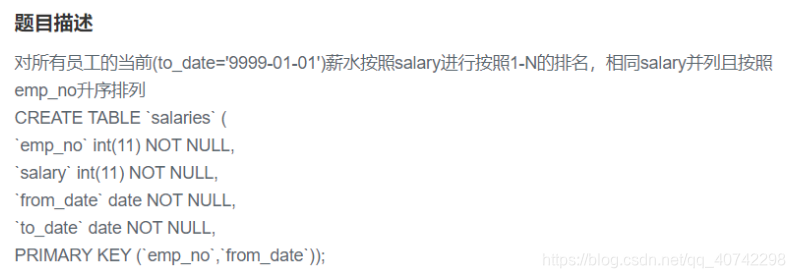往期博客: 这道题的关键就是strftime函数的使用 我觉得这一道题问的很模糊,反正我一开始写错了就是因为理解错了,这里注意一下like的用法吧,别的没什么重点。 附赠一个方法二不用子查询: 这里需要注意is NULL,可不是= NULL 这题应该是系统有bug,至少我做的时候有bug,跳过。 这题简单明了,我喜欢,就是考察一个知识点,就是字符串的连接。 但是这是sqlite的环境: 简单记录,不喜勿喷
简介
牛客网sql练习题解 (1-11)
牛客网sql练习题解(12-21)
牛客网sql练习题解(22-32)NO.22

这里面有一个小技巧即使怎么获得当前salary的排名,也就是子查询中的写法,这是一个比较常用的方法。值得记住。select s.emp_no, s.salary, tmp.rank as rank from salaries s inner join ( select distinct s1.salary, count(distinct s2.salary) as rank from salaries s1, salaries s2 where s1.to_date = '9999-01-01' and s2.to_date = '9999-01-01' and s1.salary <= s2.salary group by s1.salary ) as tmp on s.salary = tmp.salary where s.to_date = '9999-01-01' order by s.salary desc, s.emp_no; 
NO.23

select de.dept_no, de.emp_no, s.salary from dept_emp de, salaries s, employees e where de.emp_no = s.emp_no and s.emp_no = e.emp_no and s.to_date = '9999-01-01' and s.emp_no not in ( select emp_no from dept_manager where to_date = '9999-01-01' ); 
NO.24

select de.emp_no,dm.emp_no as manager_no, s1.salary as emp_salary, s2.salary as manager_salary from dept_emp de, dept_manager dm, salaries s1, salaries s2 where de.emp_no = s1.emp_no and de.dept_no = dm.dept_no and dm.emp_no = s2.emp_no and s1.salary > s2.salary and s1.to_date = '9999-01-01' and s2.to_date = '9999-01-01'; 
NO.25

这里注意一下group by的连用吧,就是对多个col进行group by,注意加逗号啊select d.dept_no, d.dept_name, t.title, count(*) as "count" from departments d, dept_emp de, titles t where d.dept_no = de.dept_no and de.emp_no = t.emp_no and de.to_date = '9999-01-01' and t.to_date = '9999-01-01' group by d.dept_no, d.dept_name, t.title order by d.dept_no; 
NO.26

strftime函数可以YYYY-MM-DD HH:MM:SS格式的日期字符串转换成其他形式的字符串。
strftime的语法是
strftime(格式,日期/时间, 修正符号、修正符号…)
还有我使用了cast函数,
用法是:
cast(col1 as 类型)
用于类型转化select s1.emp_no, s2.from_date, (s2.salary - s1.salary) as salary_growth from salaries s1, salaries s2 where s1.emp_no = s2.emp_no and (cast(STRFTIME('%Y', s2.from_date) as tinyint) - cast(STRFTIME('%Y', s1.from_date) as tinyint) = 1 or cast(STRFTIME('%Y', s2.to_date) as tinyint) - cast(STRFTIME('%Y', s1.to_date) as tinyint) = 1 ) and salary_growth > 5000 order by salary_growth desc; 
NO.27

select c.name, count(fc.film_id) from film f, category c, film_category fc where f.description like '%robot%' and c.category_id = fc.category_id and fc.film_id = f.film_id and c.category_id in ( select category_id from film_category group by category_id having count(film_id) >= 5 ) group by c.category_id; 
NO.28

常规操作select f.film_id, f.title from film f where f.film_id not in ( select f1.film_id from film f1 join film_category fc1 on f1.film_id = fc1.film_id ); 
select f.film_id, f.title from film f left join film_category fc on f.film_id = fc.film_id where fc.category_id is NULL; 
NO.29

这题比较简单,唯一我觉得稍微注意一些的,把子查询放在where会比较好一些,当然放在from里面也没有错误。select f.title, f.description from film f inner join film_category fc on f.film_id = fc.film_id where fc.category_id in ( select category_id from category where name = 'Action' ); 
NO.30
NO.31

这和数据库的版本和环境有关系,
MySql支持CONCAT方法:select CONCAT(CONCAT(last_name, " "), first_name) as Name -- select CONCAT(last_name," ",first_name) as name from employees from employees; select (last_name || " " || first_name) as Name from employees; 
NO.32

这怎么越做越回去呢??create table actor( actor_id smallint(5) not null, first_name varchar(45) not null, last_name varchar(45) not null, last_update timestamp not null default (datetime('now', 'localtime')), primary key(actor_id) ); 
大家共勉~
本网页所有视频内容由 imoviebox边看边下-网页视频下载, iurlBox网页地址收藏管理器 下载并得到。
ImovieBox网页视频下载器 下载地址: ImovieBox网页视频下载器-最新版本下载
本文章由: imapbox邮箱云存储,邮箱网盘,ImageBox 图片批量下载器,网页图片批量下载专家,网页图片批量下载器,获取到文章图片,imoviebox网页视频批量下载器,下载视频内容,为您提供.
阅读和此文章类似的: 全球云计算
 官方软件产品操作指南 (170)
官方软件产品操作指南 (170)